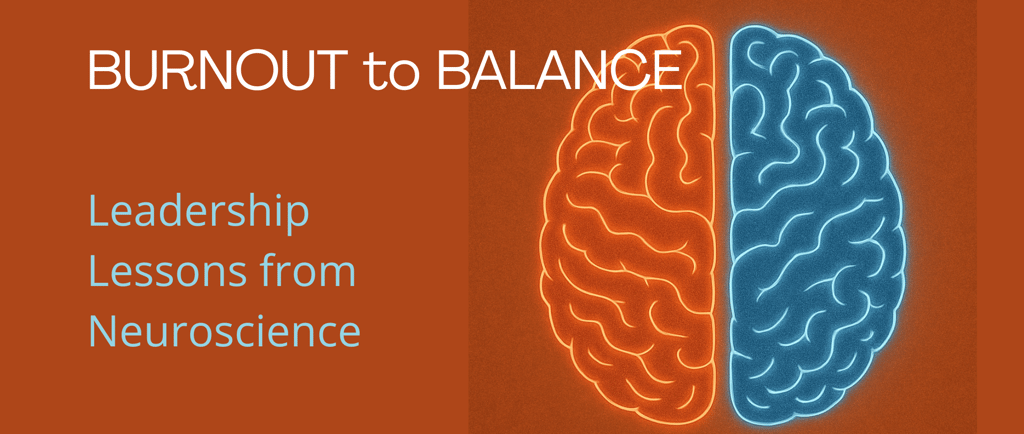Burnout to Balance: Leadership Lessons from Neuroscience
Discover how neuroscience explains the hidden drivers of burnout—and what leaders can do to protect both themselves and their teams. This post offers science-backed insights and practical strategies for moving from depletion to balance, unlocking resilience and sustainable performance.
9/9/20254 min read


Burnout isn’t just a personal struggle. It’s a leadership challenge.
High-achieving employees—and yes, many leaders themselves—are especially vulnerable. The same drive that powers excellence can also push people into depletion.
For leaders, the stakes are doubled: they must protect their own energy while also noticing when their teams are at risk. Neuroscience helps us understand how burnout happens—and what leaders can do to build cultures of balance that last.
The Leadership-Burnout Paradox
High achievers often override their own limits. They stay late, stretch beyond their role, or keep chasing the next win. Neuroscience explains that:
Chronic stress floods the body with cortisol.
The amygdala (the brain’s threat detector) becomes hyperactive.
The prefrontal cortex (the “CEO brain”) loses efficiency.
The result is decision fatigue, emotional reactivity, and a collapse in creativity. What looks like a performance issue is often a brain pushed past its operating range.
Managing the Brain’s Energy Budget
The brain runs on a finite daily energy budget. How that budget is spent matters for both leaders and their teams.
Dopamine and motivation: The brain is wired to chase rewards—recognition, wins, progress. But chasing every carrot drains energy quickly, and over time each reward delivers less return. Employees who spend too much of their mental budget on “more, faster, now” often end up in diminishing cycles.
The Default Mode Network (DMN): This is the brain’s big-picture system. It activates during reflection, rest, and creative downtime. When people never unplug—back-to-back meetings, constant emails—the DMN can’t do its job. The result is mental fatigue and diminishing creativity, a hallmark of burnout.
Balance comes from managing both sides of the energy equation: depletion and replenishment.
The Scarcity Trap
When resources are thin, the brain’s scarcity wiring narrows attention to immediate threats. Leaders and team members alike may overcompensate, trying to “make up the difference” by working harder and longer.
The problem is that scarcity reduces working memory and increases errors. The more people push, the more mistakes compound. And sometimes, covering every gap isn’t a favor—it prevents the organization from seeing what truly needs to change.
The Self-Talk That Drives Burnout
Overwork is often fueled not just by external demands but by internal dialogue. Leaders can help by recognizing these thought patterns in themselves and in their people:
The Recognition Chase
“If I do more outside my job description, I’ll finally get rewarded.”
➝ The dopamine-carrot trap. Overextension without recognition leads to exhaustion.The Dopamine & Endorphin High
Overwork can feel good—for a while. Small wins release dopamine, and long hours can even trigger endorphins. But this “overdrive high” masks depletion and disrupts sleep, hormones, and immunity.The Scarcity Reflex
“If resources are thin, I have to do everything myself.”
➝ A reflex that distorts judgment and drains strategic focus.The Invisible Gap Illusion
Covering every weakness may keep things afloat but prevents the organization from noticing systemic gaps that need attention.
Recognizing these thought patterns is the first step to choosing a healthier response.
Stress, Resilience, and Neuroplasticity
Brains can reset. Stress doesn’t have to be permanent.
Not all stress is harmful. Eustress—short bursts of challenge—sharpens focus, fuels learning, and energizes performance. It’s the kind of stress that comes with a big presentation, a tight but achievable deadline, or stepping into growth.
But when stress is chronic or overwhelming, it shifts into distress. Cortisol floods the system, disrupting the hippocampus (memory and learning), heightening reactivity in the amygdala (fear and threat detection), and impairing the prefrontal cortex (judgment, planning, self-control). That’s when motivation collapses into exhaustion.
The good news is that neuroplasticity allows the brain to adapt. Habits of recovery—sleep, exercise, mindfulness, balanced nutrition—strengthen resilience and restore balance.
The Neuroscience of Balance
Balance isn’t about lowering ambition—it’s about aligning physiology with performance.
Calm and drive: Brains need both. Too much drive without recovery creates anxiety, insomnia, and poor decisions.
Parasympathetic resets: Breathwork, mindfulness, and movement activate the nervous system’s “brake pedal.”
Recovery as productivity: Rest is not indulgence; it’s part of sustainable performance.
Balance is the rhythm of depletion and replenishment. Leaders who respect that rhythm—and help their teams do the same—unlock more creativity, clarity, and innovation.
Key Takeaways for Leaders
Spot the signs of depletion. Errors, reactivity, and mental fog are often signs of a brain running on empty, not lack of motivation.
Guard the energy budget. Protect reflection time and discourage endless carrot-chasing. Encourage your people to manage their daily mental energy like a finite resource.
Challenge the scarcity reflex. Don’t drain yourself or your team trying to cover every gap. Sometimes gaps need to remain visible for systems to adapt.
Call out harmful self-talk. Recognition chasing, overdrive highs, and “do it all” reflexes drain energy. Naming them gives people permission to reset.
Model recovery. Sleep, breaks, and micro-resets aren’t luxuries—they’re strategies. When leaders normalize recovery, teams follow.
Closing Reflection
High achievement isn’t the problem. The problem is when high achievement runs unchecked, powered by scarcity and self-talk instead of balance and focus.
As a leader, your role is twofold: protect your own brain and help your people protect theirs. Neuroscience shows us that balance isn’t weakness—it’s the foundation of sustainable performance. When the brain’s big-picture systems like the DMN are deprived of downtime, the result is fatigue, lost creativity, and burnout.
So ask yourself:
Where might scarcity or self-talk be driving overwork on my team?
What gap am I covering that actually needs to be seen?
What recovery ritual can I model this week that gives permission for others to do the same?
True leadership is not burning out for the mission—it’s creating conditions where people can thrive for the long run.
SYNERGYLM, LLC
liz.michael@synergylm.net
7901 4th St. N #25825
St. Petersburg, FL 33702
© 2025. All rights reserved.


